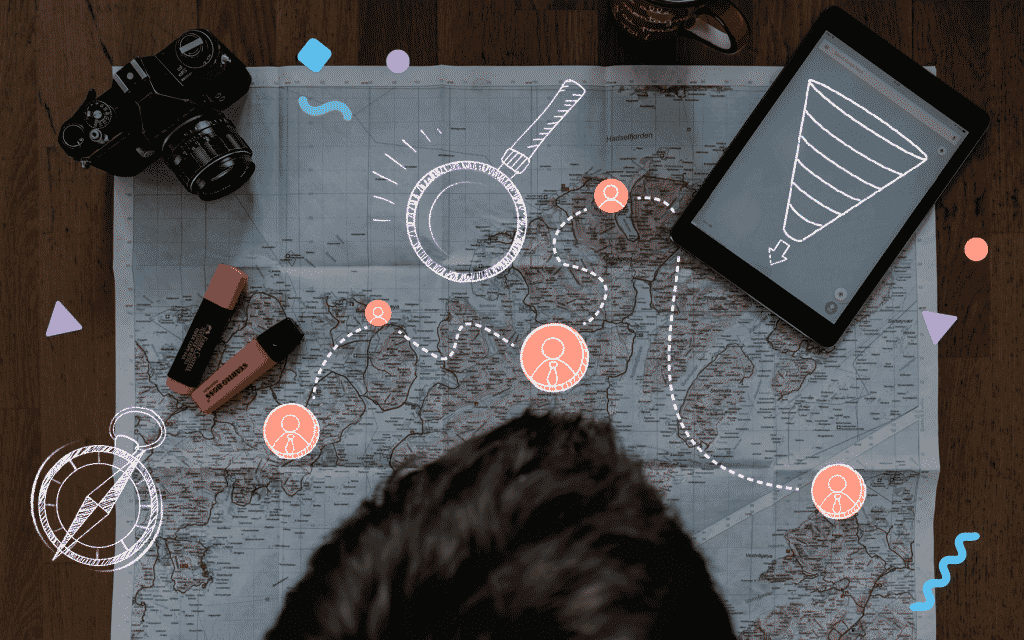Most definitely, all the “evergreen customer acquisition strategies” fall apart when neglecting one crucial element — the customer acquisition funnel. But that’s easy to fix, what with the tons of ready–to–use templates that can be found on the internet, right?
Wrong.
I know we all love convenient shortcuts, but those lead to nowhere in complicated cases. And creating a customer acquisition funnel is a particularly tough nut to crack since it requires personalization, optimization, and constant revision.
Wait, revisions? Yes. Unfortunately, it’s not enough to create your sales funnel once. Our world and consequently, customers’ behavior, changes too fast. And we need to do our best to keep pace with that.
That’s why an in–depth understanding of the funnel is crucial to ensure that your customer acquisition efforts don’t go to waste. So if that’s what you want to gain, you’re in the right place.
Get comfortable and make yourself a cup of coffee. This is going to take a while.
Customer Acquisition Funnel
Definition
Customer Acquisition Funnel is a model representing the customers’ journey from the first time they notice your brand to when they become paying customers that come back for more. This model is helpful in creating a sound strategy that covers all the important bases, like lead generation, conversion, and retargeting, among others. It also helps with discovering any weak spots that could use some improvement and identifying the risks.
Traditional Model
The alleged first ancestor of the modern funnel is the purchase model proposed by Elias St. Elmo Lewis in 1898. Today it’s better known as the AIDA model, which turned out to be universal and timeless enough to be in use to this day. But not necessarily by the sales team — it moved more in the direction of advertising, instead.
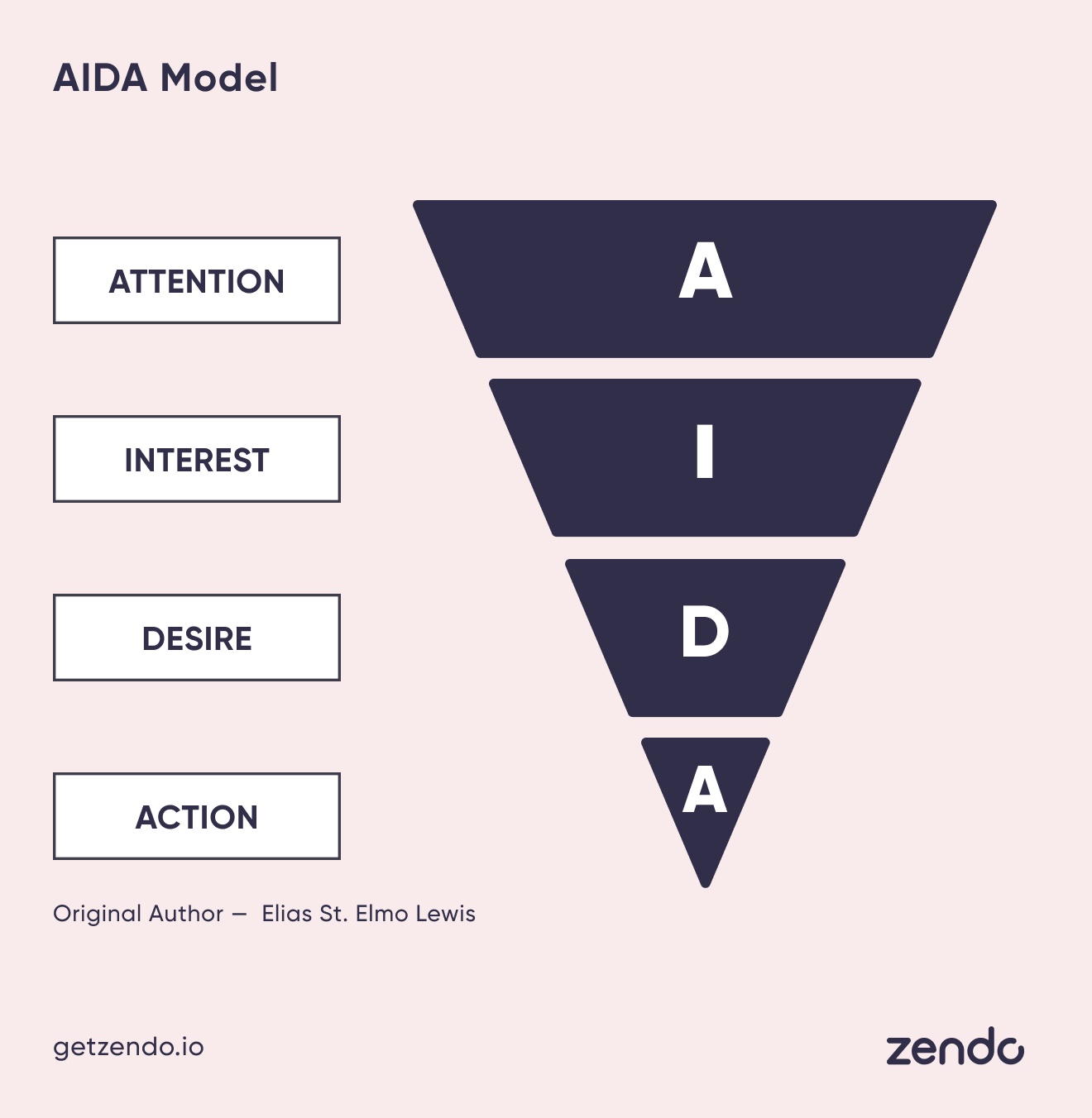
Traditional AIDA consists of four stages:
- Attention — when the client takes notice of your brand, product, or service. For example, by seeing ads of your store on Facebook or by hearing a recommendation from happy clients or even influencers;
- Interest — when the client shows interest in what you offer. That interest can be cultivated by capturing the problem in your message that your potential client is having or by showing a hefty discount. You can see proof of that interest when a potential customer signs up for your newsletter or downloads an ebook;
- Desire — when the client shows desire for what you offer. You can cultivate that desire in many ways — by showing testimonials, explainer videos that showcase all the features of the product or service, or putting an emphasis on its benefits. There might be some external factors holding the customer back: money, for example. It’s good to offer discounts or free trials for that purpose;
- Action — when the client decides to take you up on your offer, that is by making a purchase. Mission complete!
AIDA is also used in creating any sort of messages, from emails, landing pages, or even short articles. Then it works like that:
1. Attention — you grab your recipients’ attention with a catchy headline;
2. Interest — you cultivate their interest with information that’s relevant to their circumstances (it’s best to address problems they might be having);
3. Desire — you cultivate their desire into what you offer by listing your product’s features and benefits that could solve their problems;
4. Action — you end the message by encouraging the recipient to do a certain action: answering the message, scheduling a meeting, or even calling you.
Currently, this model is way much more popular (and effective) in copywriting than in sales. Why is that?
There are 4 main issues that made it unable to stay in the modern sales department. The problems are as follows:
- AIDA is too linear. It’s based on the assumption that people will go through the exact phases one–by–one, while nowadays, the journey is more convoluted and people enter the funnel through different stages;
- AIDA presumes it’s easy to gain attention. Today, one of the biggest marketing challenges lies in capturing and maintaining attention. The competition fights tooth and nail for that privilege, while the people are tired of being constantly bombarded by glaring ads;
- AIDA is focused on the sale process only. There’s no accounting for marketing efforts since it originally only served as a winning formula for salespeople to use;
- AIDA ends with the sale. It’s a well–known fact that retaining existing customers is more beneficial than putting all your effort into acquiring new ones — and it’s cheaper, too.
AIDA, at its heart, is still a useful model worthy of our attention. But it severely oversimplifies the customer journey and taken too literally, can lead to nowhere. That’s why there are many variations of the traditional model.
Let’s briefly go over them.
Variations of The Traditional Model
AIDAS
AIDAS is practically the same model as AIDA, only with the additional Satisfaction stage which accounts for customer retention. It’s important to deliver such an excellent service, that the client will happily come back for more.
TIREA
TIREA stands for:
- Thought — when the potential customer takes notice of your brand for the first time;
- Interest — when the potential customer shows interest in your brand;
- Risk Evaluation — when the potential customer lists pros and cons of taking you up on your offer and compares your brand to others;
- Engagement — when the potential customer engages with your brand by signing up for your newsletter, webinar, or downloads your content;
- Action — when the customer makes a purchase.
TIREA model also doesn’t account for retention, but it does account for clients having doubts and analyzing the competition. A salesperson can keep that in mind and find unique angles that will show their product or service as one of a kind.
REAN
REAN model proposes a more universal approach, which is flexible enough to be tailored to specific needs.
- Reach — this stage focuses on reaching the right target audience through specific acquisition channels. All your efforts will be wasted if your content gets lost in the void;
- Engage — this stage focuses on how your target audience interacts with your content — by reading it, downloading resources, following your brand on social media, and so on. Here, you want to captivate your audience;
- Activate — this stage is all about conversion, that is turning potential buyers into happy customers;
- Nurture — this stage focuses on remarketing. If someone bought from you once, it should be easier to convince them to do it again — as long as the customer service team did an excellent job.
ACTLA
- Awareness — when your target audience gets to know your brand for the first time due to your efforts;
- Consideration — when a potential client starts wondering whether you’re worth their money;
- Transaction — when your prospect turns into a client by making a purchase or acquiring your services;
- Loyalty — when your client repeatedly makes purchases or acquires your services;
- Advocacy — when your happy clients turn into brand advocates that recommend you to other potential clients.
This model triumphs over the others by putting a strong emphasis on remarketing and brand advocacy — two strategies that are hard to pull off, but are incredibly powerful.
As you can see, all the variations are more or less similar to each other. This proves that you can choose the one that suits your business best and put emphasis on different parts of the funnel. There are other funnels though that have gained popularity.
The AARRR! Metrics
The AARRR! Metrics, also called the Pirate Metrics, were created by Dave McClure in 2007. They consist of five stages:
- Acquisition — the process of raising brand awareness among your target audience via different means, such as advertising, word–of–mouth, social media marketing, and so on;
- Activation — here is where conversion happens; when the customer decides to make a purchase or signs up for the trial version of the product;
- Retention — once the customer is acquired, it’s necessary to keep their interest in order to convince them to spend more on your brand. Offering helpful support, fixing any issues, and staying ahead of your competition is crucial to make them keep using your product or service;
- Referral — it’s also as important to ask for clients’ feedback, include their testimonials in visible spaces (for example — on social media), and ask them to share their experience with their own audience. Referral programs, although hard to do well, are extremely powerful strategies that should be utilized as much as possible;
- Revenue — the last part of this metric focuses on analyzing your revenue, looking for things to improve, and changing what doesn’t work. Only thanks to thorough analysis can you truly measure campaign success.
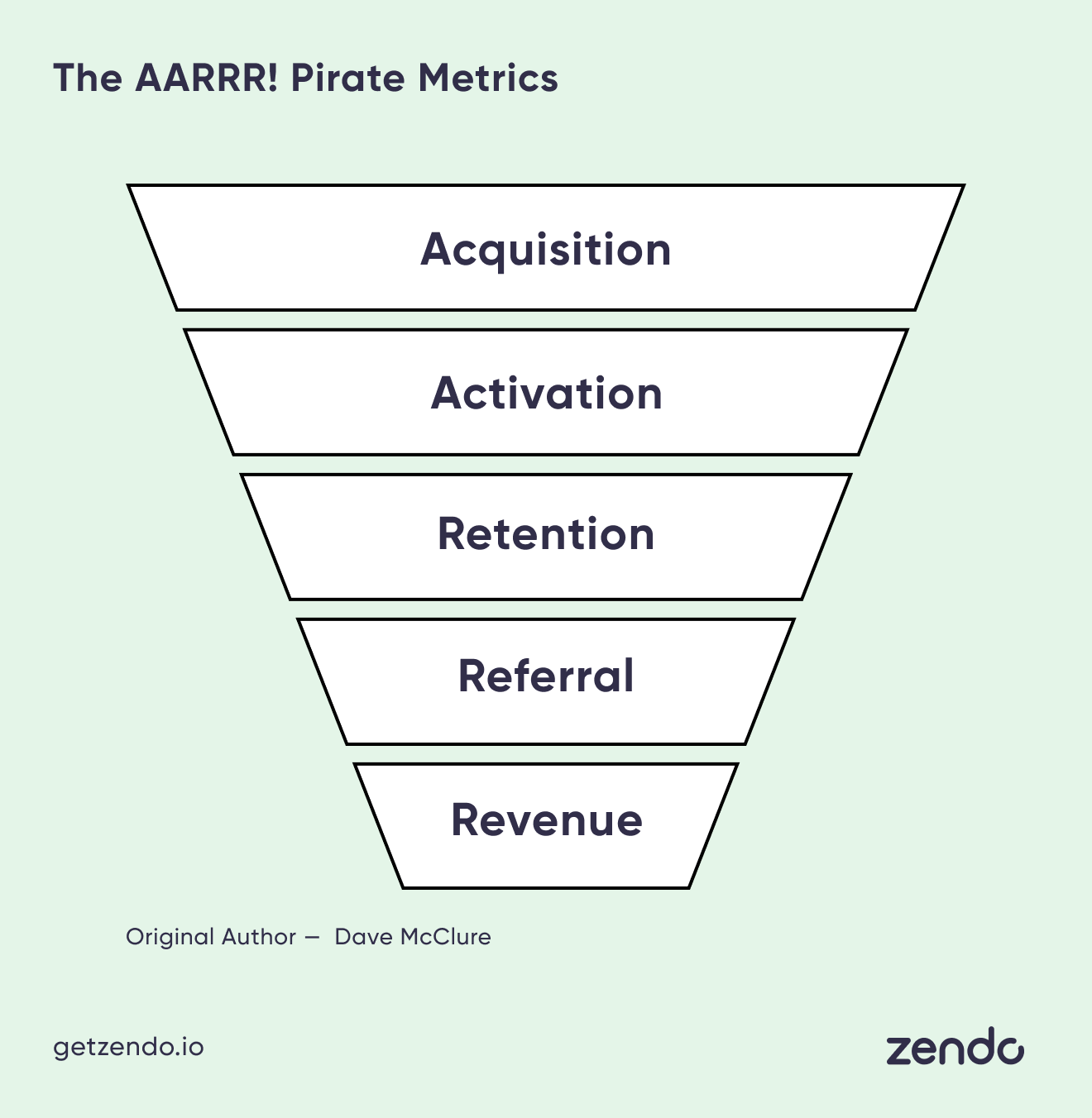
This model puts a strong emphasis on turning new customers into loyal ones and building a community that will support you in the long–run. This makes the best of strategies that are proven to be the most effective — but are also the most difficult to implement properly. Improving the process of retaining customers will always be a great idea to better your business.
TOFU, MOFU, BOFU
But hold up! Why is everything a funnel in the first place?
Funnel is the best visual representation of the customer’s buying process due to its shape: at first, you reach out to a wide audience. Part of that audience will become interested and can be considered prospects, and only a part of those prospects will be successfully converted into paying customers. So the farther we go, the fewer people we have to work with.
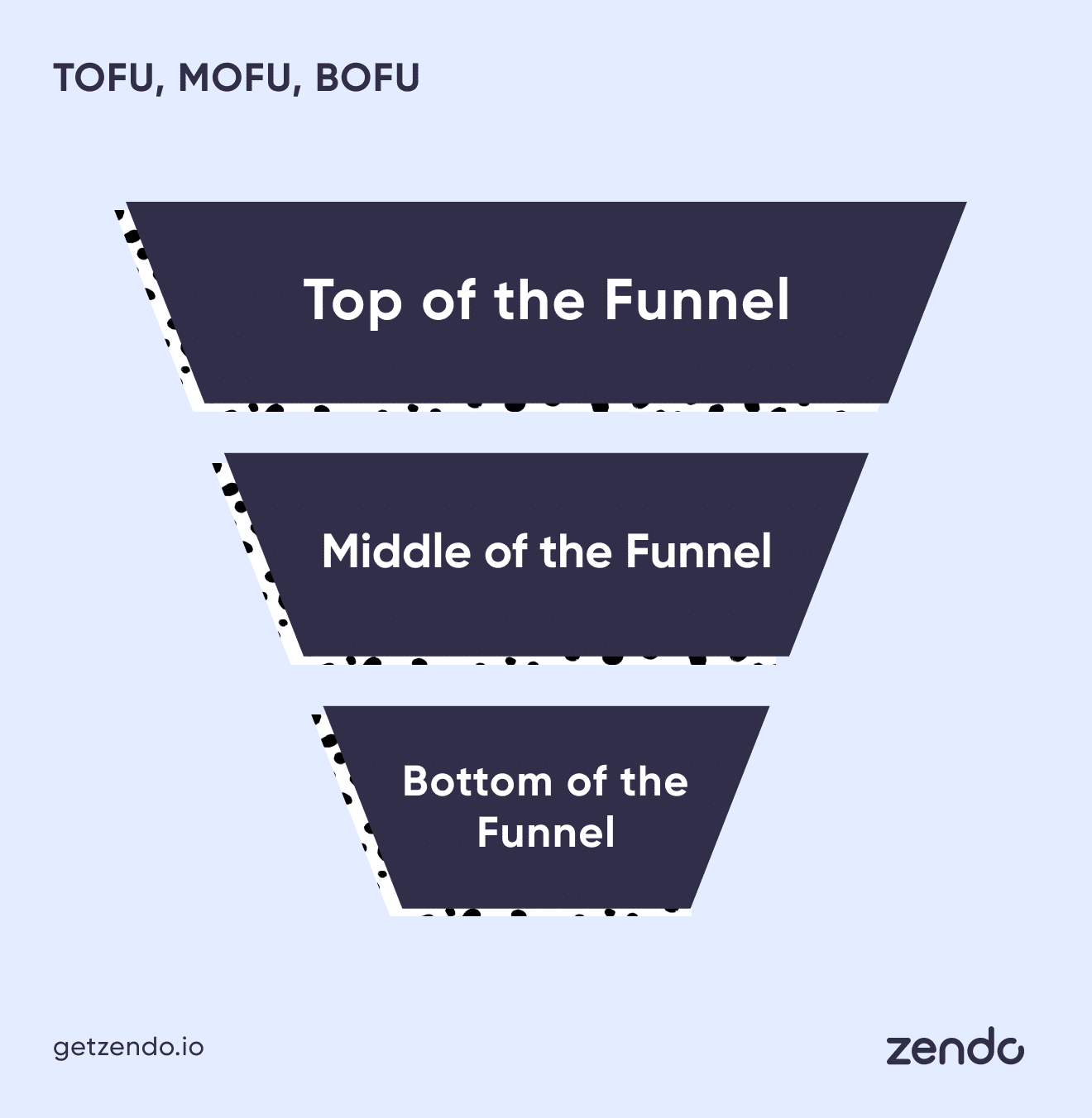
Any funnel can be divided into three parts:
- Top of the Funnel (TOFU) — which applies to the biggest audience we raise brand awareness in,
- Middle of the Funnel (MOFU) — which applies to prospects that show interest in our brand,
- Bottom of the Funnel (BOFU) — which applies to the paying customers.
But what does this mean for you?
For each part of the funnel, you should create different content that suits each level best. The wider the audience, the more general content you should create — think of it as planting the seed in general awareness. It’s enough to make the audience think of your brand, to associate it with certain images or feelings.
For the middle part of the funnel, you should deliver more personalized content that answers any questions potential customers might have.
For those who are close to buying your product, you should give them a small push, and those who already made a purchase should be encouraged to give referrals or spread the word of how awesome you are.
And then retarget them.
The Funnel Is Dead. Long Live The Funnel
To truly embrace the strategy of nurturing existing customers, the traditional funnel changed its shape to reflect that.
Introducing: the double–ended funnel.
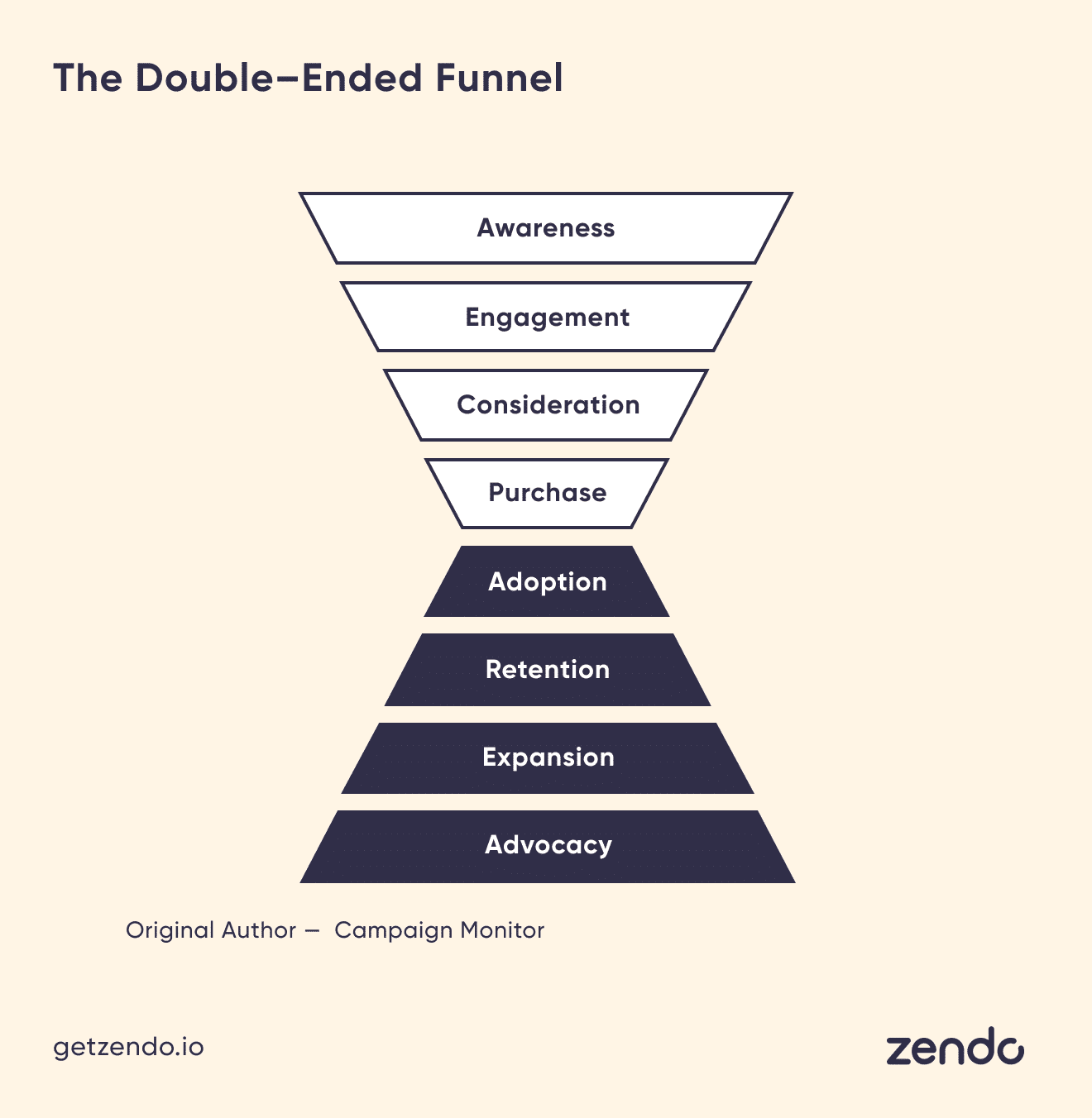
The double–ended funnel consists of 8 stages:
- Awareness — informing the audience of your brand’s existence via ads, commercials, direct mail, and so on;
- Engagement — informing the prospects of your specific products or services that solve certain problems via blog posts, podcasts, webinars, and other forms of content;
- Consideration — explaining in–depth the advantages and benefits that come with purchasing your products or services that give you an edge over the competition;
- Purchase — leading the customers through excellent customer service that leaves nothing to be desired;
- Adoption — arming the customer with knowledge, resources, and support to ensure dependency on your brand;
- Retention — implementing a customer retention strategy that will keep the customer engaged. For example, by inviting them into the community, offering discounts, additional resources, or sending them surveys;
- Expansion — implementing new solutions and improvements to further enhance customer experience based on user feedback;
- Advocacy — encouraging loyal customers to recommend you via a referral program and turning them into brand ambassadors.
This double–ended funnel can be considered the most comprehensive one — it definitely won’t let you forget about any step. But even with all the additional stages, the funnel is still just a funnel, double–ended or not. It assumes that a client goes through a linear journey that’s the same for everyone else. It’s an overly simplified outlook on a customer’s journey that might limit the opportunities of your sales and marketing teams. Today, the customer’s journey is more convoluted and requires another form of visualization — for example, a flywheel.
The Flywheel Is The New Funnel

The Flywheel Model, proposed by Hubspot, recognizes the power that loyal customers wield. They’re the main force behind business success and are the key to customer acquisition cost reduction.
The flywheel consists of three phases:
- Attract — this phase focuses on raising brand awareness via marketing campaigns and by creating relevant, up–to–date, and useful content that brings real value. It also builds your authority as an expert in the chosen field;
- Engage — this phase focuses on interacting with the prospects via different channels by inviting them to communities, offering free content and useful resources, sharing your knowledge, and so on. In short — giving them a strong reason to keep being invested in your business;
- Delight — this phase focuses on constant improvement of customer service. The buying process should be painless, quick, and easy, and those who already made a purchase should have the option to join loyalty programs, get discounts, and enjoy any other rewards that will make their investment worthwhile. Support should also be top–notch — nothing spoils the experience like warranty issues, for example.
The main idea behind the flywheel lies in the presumption that the delighted customers will attract new prospects on their own. This gives you the momentum to keep the wheel spinning — which is your force that will keep your business in motion. But you need to beware of friction, which slows down the wheel: the friction is caused by making the buying process extensive, asking for more personal information than necessary, or creating websites with a bad user experience. This will discourage the potential client and move on to your competition.
Since this strategy is dependent on a strong community, it’s best to implement it once it’s big enough. Otherwise, it will take a while to gain momentum.
There Are Also Loops
Proposed by Blue Corona, the Looping Journey consists of four stages:
- Awareness — when the target audience takes notice of your brand;
- Consideration — when the prospects weigh your brand, products, and services against your competitors;
- Purchase — when the prospects turn into clients by making a purchase;
- Post–purchase experience — when you deliver excellent support and onboarding processes to make the clients really satisfied with the whole experience.
What makes this approach unique are the two additional loops:
- Research and discovery loop — present in the consideration stage. This emphasizes the process of the client’s self–education, which is often the result of mistrust towards marketing strategies;
- Experience and loyalty loop — present in the post–purchase stage. This emphasizes the process of turning clients into loyal customers and brand advocates.
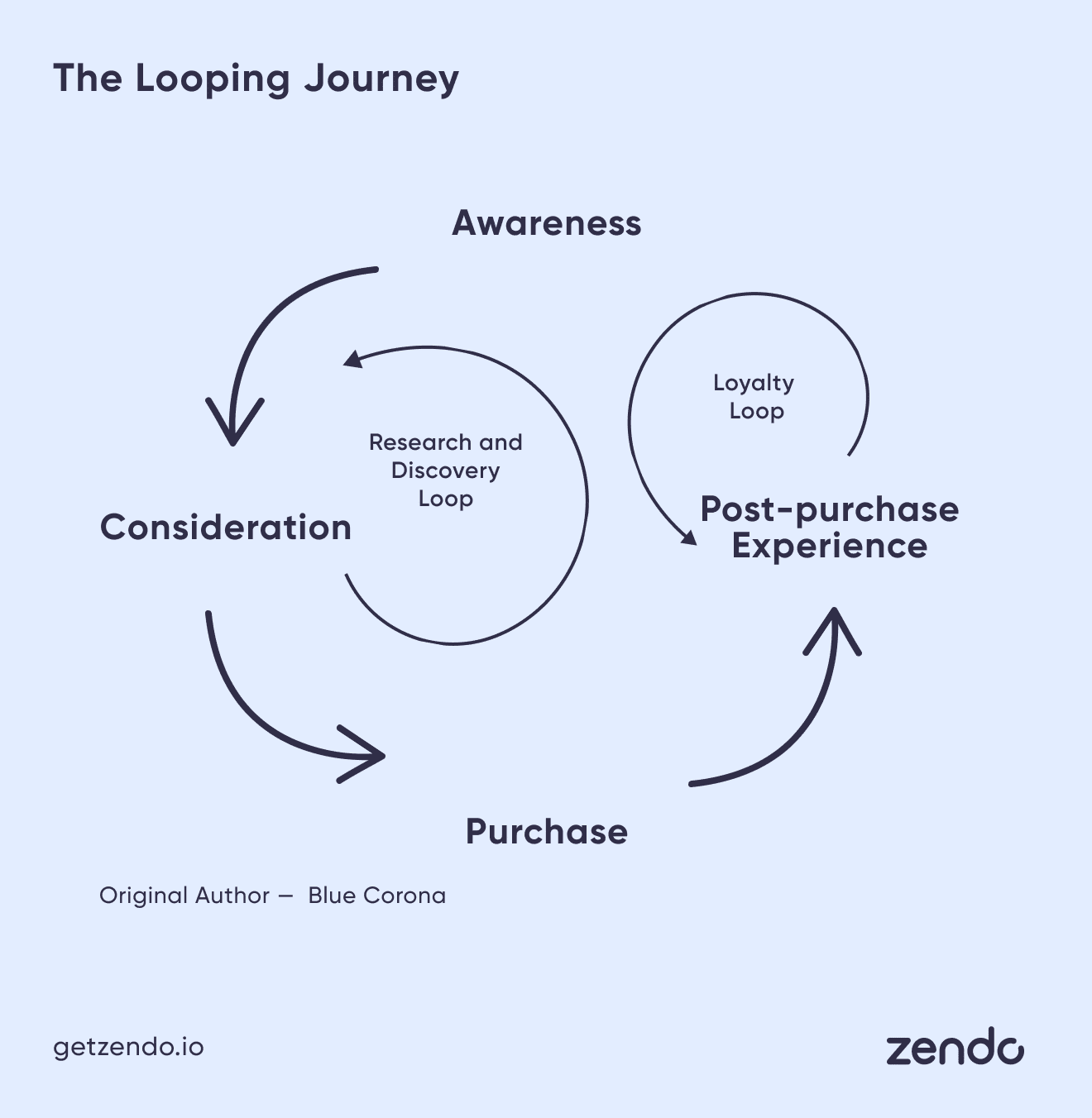
These loops are necessary to show that a customer’s journey is more complicated than the traditional funnels lead us to believe. People can enter the loop at any time and at any stage, they can be stuck in places for long periods of time or keep moving backward — almost crossing the purchase stage but going back to consideration, for example.
This presents a challenge — the previous models provided a clear–cut structure for creating and dividing our content. Here, it makes us consider more variables and admit that we can’t really control the customer’s journey. We can only ensure that our message across all the stages is true, consistent, and convincing.
So Many Choices! What To Do?
With the variety of funnels and other models available for use in marketing, it’s easy to get overwhelmed. How to pick the one that will suit you best?
Learn from your competition
Especially from those who’ve been active on the market for a while now. They already know what works well and what doesn’t. They will know the profile of their ideal customer, which customer acquisition channel is the most popular for their target audience, what kind of messages are the most effective. You can also learn from their mistakes, especially if there were any scandals. For example, Fiverr has learned that promoting working yourself to death isn’t really all that great.
Identify customer behavior
Depending on what you offer, your potential clients will exhibit different behaviors. People that prepare themselves to buy expensive products will spend more time on research. People won’t research chocolate bars as much — most probably, they will buy it on a whim once they see it next to the checkout.
Discover which stage is the most important to you
Certain companies have to be a little bit more creative in order to convince people that they need yet another trinket. To do that, the campaigns most often create positive associations with the product: prestigious lifestyle, creating new wonderful memories, self–development. Other companies, the ones that answer a direct need, have an easier time doing that — they don’t really have to convince others that fixing the leaking roof is a good thing. They only need to give a reason why they’re better than their competition. So in this case, the consideration stage is more important than brand awareness.
Experiment
Marketing, although it’s often accompanied by math, can be a very surprising and unpredictable thing. What was a proven strategy yesterday can be a bad strategy tomorrow — especially since customer behavior is heavily influenced by what’s happening in the world, like the pandemic. So it’s important to keep adjusting your strategy and letting go of the solutions that are a thing of the past.
Measure Your Success
To be able to properly tell whether you’re doing fine or not, it’s best to introduce some numbers. Metrics such as Customer Acquisition Cost, Customer Lifetime Value, or CAC/CLV Ratio can help you keep track of what’s really going on in your business. Sometimes you might think everything is fine — but those numbers can give you early warning signs or paint a completely different picture. So learn how to use them. And most importantly — how to interpret the results.
My Model is Not Working!
Even when taking all of the above into consideration, you can still experience some issues. What to do then?
Diagnose The Problem
This is the most important thing to do when something doesn’t work — identify the problem. It can be a tricky process due to the fact that different problems may result in the same symptoms — for example, lack of conversion might be a result of forms that require too much personal information instead of inadequate copy.
Also, you might mistake existing symptoms for the real problem. Treating only the symptoms will give you a short–term relief, but most probably, the real problem will come back to bite you in the budget later on.
While there are way too many potential problems that clog or leak your funnel, let’s look at some examples.
The Funnel Is Too Complicated
Your overly personalized and overdesigned funnel is too complicated for the clients to make sense of the process — they just want to buy a service, but instead, they’re bombarded with cross– and up–selling strategies, daily newsletters, and overly eager invitations to all of your groups on so many channels. Moreover, your employees don’t know what they’re doing either — instead of closing the deals, they’re stuck in implementing all sorts of experimental tactics they don’t understand the point of.
Marketing And Sales Team Don’t Cooperate
Moreover, there might be a lack of communication between your marketing and sales teams. They have different pieces of information and they don’t work together. For example:
- The sales team doesn’t pass on the client’s feedback,
- The sales team doesn’t inform where the leads came from,
- The sales team’s brand message contradicts the marketing one’s.
On the other hand:
- The marketing team neglects to explain their strategy in a clear way,
- The marketing team generates unsuitable leads that are not beneficial,
- The marketing team promises what the sales team cannot sell.
How does this affect the funnel? The lack of cooperation and feedback makes it impossible to truly evaluate whether the funnel works and how it can be improved.
No Goals
Another variable affecting and effectiveness of communication is the lack of clear goals. Everyone works towards something, but there’s no clear direction nor objective. There’s no way to state whether the strategy works or not because there are no metrics to analyze. Again, all the employees are working blindly, not knowing how their actions affect the whole customer acquisition process. They might not be even aware that they sabotage the efforts of the whole team, and at the same time — the effectiveness of the funnel.
The easiest way to fix this is to introduce a framework called Objectives and Key Results (OKR), which enforces a specific way of thinking about your projects in terms of goals as well as constant revision of your ongoings.
You’re Too Eager
Everyone wants to see the results of their work as soon as possible. After all, it’s the only way to confirm that your work truly matters. But in many cases, you need to wait a long while before you can reap the rewards.
This requires patience. You can’t change your whole strategy after just a month or deem one social media channel useless without giving it the chance to truly shine.
For example:
- To reach 1,000 subscribers on Youtube, you might need 22 months,
- To reach 100,000 followers on Instagram, you might need 18 months,
- To see SEO results, you might need at least 6 months.
You Don’t Automate
There’s also a possibility that your teams waste their time on time–consuming, but still necessary, tasks. Thankfully, many processes can be automated or even outsourced — leaving your employees free to do what they do best and what really requires a human touch. This can make your sales model work faster, smoother, and more efficiently. For example, those who are not that great with writing any kind of content, from cold emails to social blog posts and product listings, can use Jarvis.
Conclusion
To create a truly successful customer acquisition strategy, you need to visualize your customer’s journey in any shape you need: be it a funnel, flywheel, or loop. The shape doesn’t matter all that much — what matters is your understanding of how these models work, what their limitations are, and what they really represent. They should act as your guide instead of enforcing rules that will forever direct your strategy. Your chosen model should be flexible and personalized for maximum benefits.
All in all, you should keep in mind one thing — a marketing strategy is set in motion by humans for humans. This means that it cannot be neatly broken down into numbers or wholly subordinated into a process of your creation. Expect lots of irregularities, aberrations, exceptions, and things that should work in theory but don’t.
So don’t forget that in the end, you’re dealing with real people, both in terms of your own employees and your clients.
Not just numbers.
Frequently Asked Questions: Customer Acquisition Funnel
What’s a Customer Acquisition Funnel?
Customer Acquisition Funnel is a visual representation of the customers’ journey. It starts with potential customers taking notice of the brand and ends once they make a purchase.
Is Customer Acquisition Funnel important for Customer Acquisition Strategy?
Customer Acquisition Funnel is a crucial element in any Customer Acquisition Strategy. It ensures that each step of the customer’s journey is taken care of: like lead generation, conversion, retargeting, and many more. It’s helpful in nailing down any issues, and areas that need improvement, and in identifying risks. Without it the overall analysis of customer behavior is incomplete.
What’s the best Customer Acquisition Channel?
The best Customer Acquisition Channel is the one where your target audience spends their time the most. This means that there’s no universal channel that works for everyone; it will depend on the industry and behavior of your target audience. That’s why it’s so important to make in-depth market research first and discover all the nuances pertaining to your potential clients.
Should I measure Customer Acquisition Cost?
Of course — metrics are the best way to measure your success and whether your current Customer Acquisition Funnel is working. Besides that, you should consider measuring Customer Churn Rate, Customer Lifetime Value, Average Order Value, and Conversation Rate, just to name a few.

A free online training. Delivered daily to your inbox to grow your productized agency.

